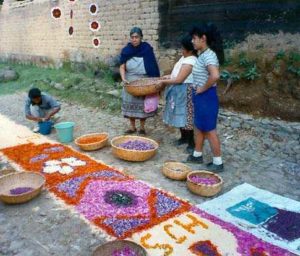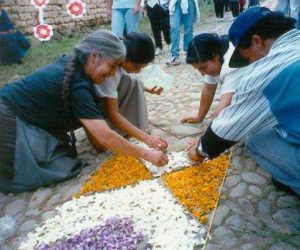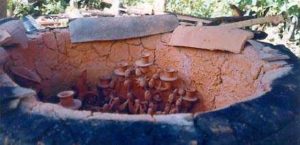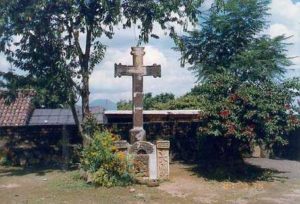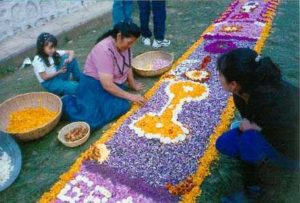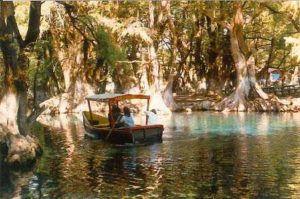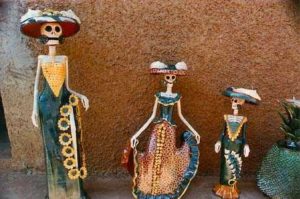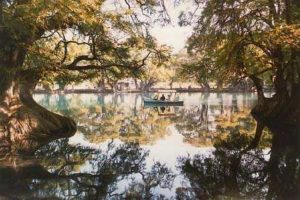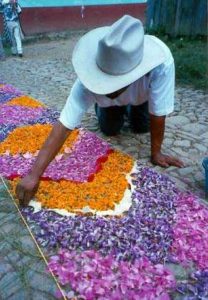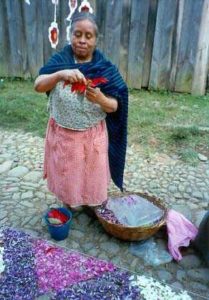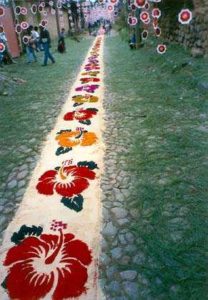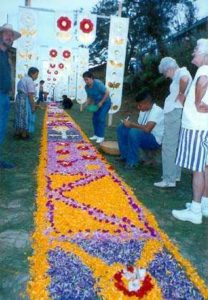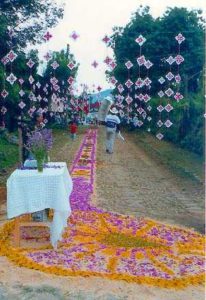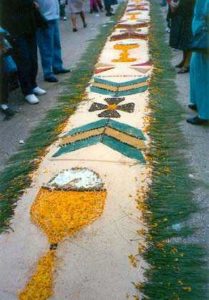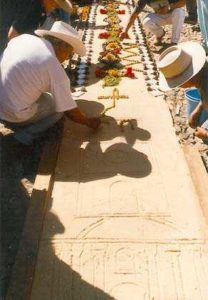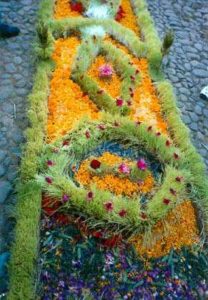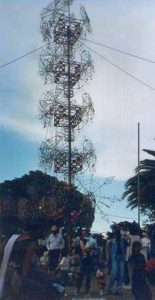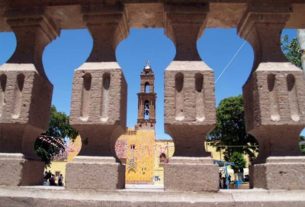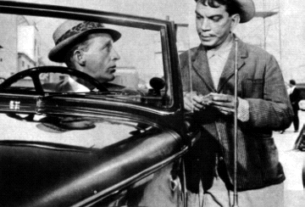Oddly enough, we couldn’t find Patamban in any of our guidebooks but when we went there on that late October weekend we found that, somehow, about a hundred thousand people had managed to congregate for the town’s annual Fiesta de Cristo Rey parade and festivities. I’m guessing at that number but, judging from the square miles of parked buses and autos in the highways and fields and vacant lots around the outskirts, plus the crowds in the streets of the little town, I’m probably not far off in my ‘guesstimate’.
We had signed up with a tour group in Ajijic to visit that part of Michoacán and there were twenty-eight of us on the bus. It’s less than a three hour trip to Patamban but we made it a weekend excursion, taking time to visit Lake Camecuaro and its famous cypress groves and the pottery-producing towns of San José de Gracias and Ocumicho. Those visits took up the first day of our excursion. But the visit to Patamban, on the Sunday, was the main attraction.
The Fiesta de Cristo Rey has become as famous as many of the Day of the Dead rites in other communities around Mexico. It’s the peak of the flower growing season in Michoacán and the residents not only gather the flowers to decorate the streets but they also paint the streets with incredible and startling floral designs. In addition, they hold a crafts fair and pottery competition and, of course, street-sellers bring their merchandise from all over the area. With the tens of thousands of tourists who attend, the end result is an amazing crowd scene that culminates in a street parade late in the afternoon leading to a shrine part way up the local mountain. It all has to be seen to be believed.
Most impressive, for this observer of the Mexican scene, was the way everyone in town seems to so solidly support the event. Our group went to Patanban fairly early in the morning and it looked as though every citizen was out working – hanging decorations, preparing food, cleaning up the streets and marking the parade route in a unique sawdust-filled track that seemed to stretch down the middle of the street for several miles. And it soon became apparent that every block had its own unique approach to the decoration process. The result was a riot of color and design.
The other two towns we visited the day before – San José de Gracia and Ocumicho – have long-established historic backgrounds. San José de Gracias is famous for pottery that features green pineapples and pigs while the artisans of Ocumicho specialize in manufacturing impish devil figures and masks. Ocumicho is also known for its whitewashed church with its 16th century stone carvings.
Back in the mid-1500’s, when the Franciscan priests were busy converting the local populations to Christianity, the rather enlightened Spanish Bishop Vasco de Quiroga set up a system of economic plans where each town specialized in the manufacture of certain kinds of artistic goods. I guess it was an initial introduction to capitalism. In many towns across Mexico – such as San José de Gracias and Ocumicho, the practise still continues. In other words, they’ve been making those pigs and pineapples and devil masks for five hundred years.
That’s not the case with Patamban. Maybe there wasn’t a town there in Quiroga’s day. So, although Patanban’s parade and all of its preparations have religious connotations it should be explained that there is no historical significance to the event. If anything, the reason for the Fiesta is economic. Rather than originating 500 years ago, it is just over 50 years old and is done to attract people and money to the town. In that regard, I would say it was an outstanding success.
The many artisans’ shops in San José de Gracia and Ocumicho are well worth a visit. Judging by the number of plastic bags that found their way on to the bus the ardent shoppers in our crowd were delighted with their purchases.
Ocumicho is one of those villages where many of the inhabitants don’t even speak Spanish. Rather, the local language is Purépecha, which one of my guidebooks says is totally unintelligible to Spanish speakers. It’s not a terribly prosperous looking place and has a somewhat alien feel to it. The women all dress in similar fashion, in colorful skirts and blouses and rebozos. I never found out why, but there are very few men to be seen. My own feeling about Ocumicho was that, after living six years in Mexico, I had finally been to a really different part of the country.
The other place in the area that is well worth a visit is Lake Camecuaro with its 300-year old cypress groves. It’s a well-kept park with a wonderful lake and lots of places for picnicking. Crystal clear natural springs maintain pools of water that are well-stocked with fish. It’s a great place to walk and take pictures with all those wonderful reflections in the clear water. Or you can rent a boat and spend an hour or two on the lake.
The park is quiet during the week but is well-filled with picnickers on Saturdays and Sundays.
Also, just a short walk from the park entrance is a good hotel, Meson del Lago. It’s a place I feel I can heartily recommend to anyone for a night’s stay.
I must make a confession before closing. It’s simply that, after praising all those preparations for the parade in Patamban, I have to admit that our group did not elect to stay to see the parade. We took a vote and the feeling was that the parade started too late in the afternoon and there were far too many vehicles – thousands, in fact, – waiting to leave the area once it was over that we could be stuck there until far into the night. So we voted to get started on our three-hour drive back to Ajijic. And – what the heck! – we’d seen a lot that day.
I think, however, there was a feeling that some of us might return next year and stay an extra day so that we could hang around and see the actual parade. And even though there were a lot of people in town, it wasn’t that difficult to get around. In any event, if you’re looking for a unique sort of excursion in Mexico next October let me recommend a visit to the area. It’s a pleasant drive and the countryside in that part of Michoacán is green and beautiful and well cultivated and one sees flowers everywhere.
The Patamban floral carpets fiesta is held every year on the Roman Catholic Feast of Christ the King, the last Sunday of October (in most years that is the Sunday before The Day of the Dead). The hotel Meson del Lago is well worth a night’s stopover.
And – who knows? – maybe we’ll see you there.

